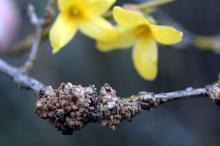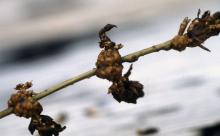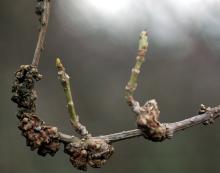Cause The OSU Plant Clinic has isolated the bacterium Pseudomonas savastanoi from galled forsythia tissue from several locations. This bacterium is also involved with a disease of olive called olive knot where similar galls are found on twigs and branches. It is suspected that it is a new pathovar but that remains to be confirmed. Infection may occur in the fall through leaf scars as in the olive knot pathogen system. Past speculation implicated the fungus Phomopsis but that seems doubtful given this new information.
Symptoms Small galls along stems and twigs of infected bushes. Galls resemble those caused by the crown gall bacterium but may be high in the bush. Multiple galls may cause loss of vigor or dieback of small twigs.
Cultural control
- Remove and destroy affected branches.
- Prune plants in dry weather.
- Clean then disinfest pruning equipment with labeled rates of bleach, Lysol, ZeroTol, or X3. Disinfestants work better on clean equipment with long contact times.
Chemical control Apply at leaf drop in the fall. Fixed coppers may be helpful, but none is specifically registered for this crop. Test the following on a few plants and observe for phytotoxicity before general use.
- Junction at 1.5 to 3.5 lb/A. Group M1 + M3 fungicide. 48-hr reentry.
- Phyton 27 at 1.5 to 3.5 fl oz/10 gal water. M1 fungicide. 48-hr reentry.
Biological control
- AmyloShield (Bacillus amyloliquefaciens strain PTA-4838) at 1.5 to 3.5 lb/A outdoor or 0.6 to 1.2 oz/gal in the greenhouse. Unknown efficacy. Group BM02 fungicide. 12-hr reentry. O
Reference Besenyei, E. and Hevesi, M. 2003. A Pseudomonas savastanoi pv. forsythiae pv. nov. szovetburjanzas betegseget okozo bakterium jellemzese (Characterization of the Pseudomonas savastanoi pv. forsythiae pv. nov. - a novel pathovar of knot disease bacterium). Novenyvedelem Hungary 393:123-128.




